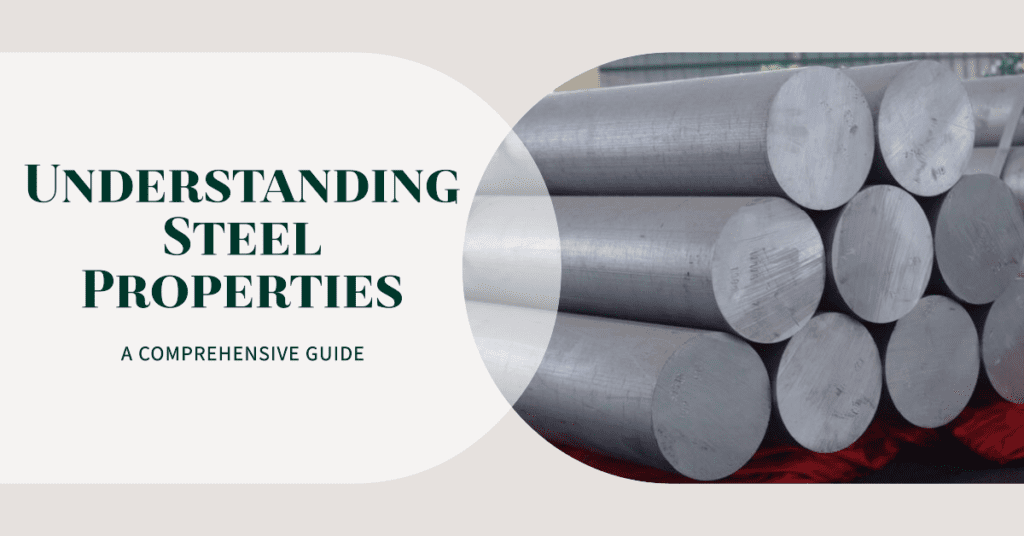
Steel, the workhorse of the modern industrial era, is an iron-based alloy known for its impressive strength, durability, and versatility. Predominantly composed of iron and carbon, steel’s properties can be altered based on the inclusion of other elements and the application of heat treatments. Steel has infiltrated every industry, from construction to automotive, aerospace to energy, thanks to its adjustable characteristics.
This article aims to delve into the properties of steel, explore different steel grades like A36, 4140, and 304 stainless, and reveal how ProLean’s Steel Machining & Fabrication Services capitalize on these properties.
Unraveling the Basics: What are the Properties of Steel?
Understanding steel properties is essential to comprehend the scope of its applications. The characteristics of steel are incredibly versatile, making it a material of choice for a wide range of industries. This versatility stems from the range of elements it can contain, the heat treatments it can undergo, and the resulting microstructures it can exhibit.
The primary properties of steel include:
- Strength: Steel is known for its high strength, making it ideal for applications where durability is paramount.
- Ductility: Steel can be stretched into a wire or hammered into a sheet, which speaks volumes about its ductility.
- Malleability: Steel’s ability to be hammered or pressed permanently out of shape without cracking makes it malleable.
- Durability: The robustness and longevity of steel make it a favorite among industries that need long-lasting materials.
- Heat resistance: Certain types of steel can retain their properties even at high temperatures, making them ideal for industries like aerospace.
- Corrosion resistance: Some steel grades have excellent resistance to corrosion and oxidation, especially stainless steel.
Furthermore, the properties of steel can be manipulated through its composition and heat treatment. For instance, adding more carbon generally increases strength but reduces ductility. Similarly, heat treatments can strengthen steel, make it more ductile, or enhance its resistance to heat or corrosion.
The Core Elements: Iron and Carbon in Steel
Steel is primarily an alloy of iron and carbon, with iron making up the bulk of the material. These two elements play a pivotal role in determining the properties of the steel. Let’s delve into the specifics of these core elements and their influence on steel’s properties.
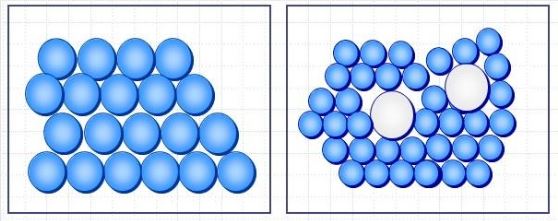
Atomic arrangement of iron & steel ( after adding carbon )
- Iron: Iron is the base metal of steel. As a pure element, iron is soft and ductile but lacks the strength and durability that make steel so desirable. However, iron’s atomic structure allows for the incorporation of carbon atoms, which dramatically alters the metal’s characteristics.
- Carbon: Carbon is the primary alloying element in steel. Despite making up a small portion of the material—typically no more than 2%—carbon significantly increases the strength and hardness of the iron. However, adding too much carbon can make the steel brittle and less ductile.
Here is an overview of the influence of iron and carbon in steel:
| Element | Effect on Steel | Applications |
|---|---|---|
| Iron | Provides the basic metallic properties, ductility | All steel applications |
| Carbon | Increases strength, and hardness, reduces ductility | High-strength applications, tools, knives |
The Science Behind Steel’s Properties: The Role of Crystal Structure
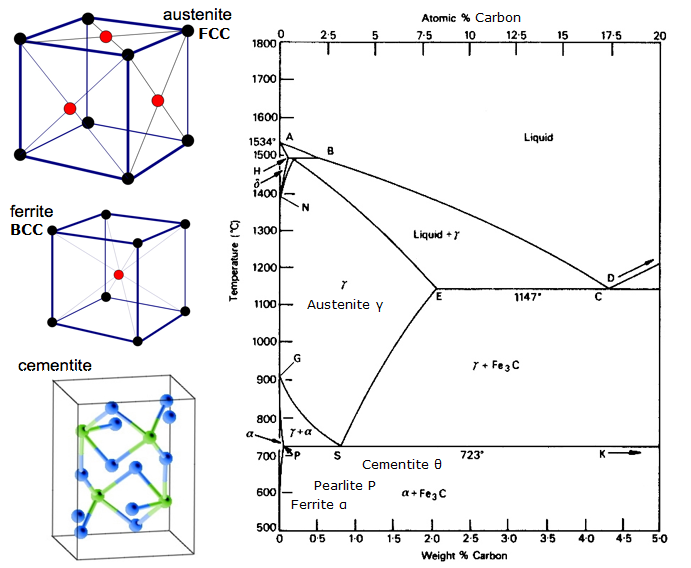
Different forms of steel based on crystal structure
The properties of steel, from its strength to its ability to resist corrosion, can be attributed to its crystal structure. At the atomic level, steel is composed of iron atoms arranged in a crystal lattice structure. This structure can change based on the carbon content and heat treatment applied, resulting in different microstructures such as ferrite, austenite, martensite, and pearlite.
Each of these structures imparts different properties to the steel. For example, ferrite has a body-centered cubic structure and is relatively soft and ductile, while martensite has a tetragonal structure and is hard and brittle. This understanding of steel’s microstructure is crucial in manipulating its properties for specific applications.
| Microstructure | Key Properties | Result from |
|---|---|---|
| Ferrite | Soft, ductile | Low carbon content, slow cooling |
| Austenite | Ductile, non-magnetic | High temperature, high carbon content |
| Martensite | Hard, brittle | Rapid cooling (quenching) |
| Pearlite | Intermediate hardness and ductility | Slow cooling from austenite |
Understanding Steel Grades and Their Properties
Each grade of steel has a unique combination of properties, determined by the specific alloying elements and heat treatment applied during its production. These grades are often standardized and defined by organizations like the American Society for Testing and Materials (ASTM) and the Society of Automotive Engineers (SAE). Some of the most common steel grades include:
- Carbon Steels This category includes low, medium, and high carbon steels. The carbon content affects the hardness and strength, with higher carbon content resulting in stronger but less ductile steel.
- Alloy Steels These steels include additional alloying elements such as chromium, nickel, and molybdenum, which improve properties like strength, toughness, and wear resistance.
- Stainless Steels Stainless steels contain a significant amount of chromium, which provides excellent corrosion resistance. There are many grades of stainless steel, each with different properties and applications.
- Tool Steels These are special steels designed to be used in tools. They often have high hardness and resistance to wear, and they maintain their properties even at high temperatures.
- Galvanized Steel: It is steel coated with a layer of zinc to prevent rusting. It’s used widely in construction, automotive, and manufacturing due to its corrosion resistance and durabilit
The following table provides a brief comparison of the properties and uses of these different steel grades:
| Grade | Key Properties | Common Uses |
|---|---|---|
| Carbon Steels | Varying hardness and strength based on carbon content, good machinability | Structural applications, gears, shafts |
| Alloy Steels | Enhanced strength, toughness, wear resistance | Automotive components, pipelines |
| Stainless Steels | Excellent corrosion resistance, good strength | Cutlery, surgical instruments, appliances |
| Tool Steels | High hardness, wear resistance, withstand high temperatures | Cutting and drilling tools |
A36 Steel Properties: Versatility at Its Best
A36 steel is one of the most common types of steel used in construction and heavy equipment. It is a low-carbon steel, meaning it has a lower carbon content than many other steels, resulting in more ductility and weldability. Here are some key properties:
- Strength and Hardness: A36 steel has a good balance of strength and hardness, making it durable enough for many applications while still being easy to work with.
- Ductility and Weldability: With less carbon content, A36 steel is more ductile and has excellent weldability, making it a suitable choice for applications that require welding.
- Good Machinability: A36 steel is relatively easy to machine, making it a cost-effective choice for many applications.
Here’s a table summarizing A36 steel properties:
| Property | A36 Steel | Applications |
|---|---|---|
| Strength & Hardness | Good balance, suitable for many applications | Building structures, bridges |
| Ductility & Weldability | Excellent, due to low carbon content | Welded structures, pipelines |
| Machinability | Good, cost-effective | General machining, manufacturing parts |
Despite its many advantages, A36 steel does not offer significant resistance to corrosion. Therefore, it may need to be treated or painted to increase its lifespan in corrosive environments. However, its versatility and affordability make it an attractive choice in a wide variety of applications.
4140 Steel Properties: The Powerhouse Alloy

Different 4140 steel parts
4140 steel is a chromium-molybdenum alloy steel known for its high strength, hardness, and excellent machinability. It offers superior toughness, wear resistance, and can be heat treated to increase its strength further. Here are some key properties of 4140 steel:
- Strength and Hardness: 4140 steel possesses exceptional strength and hardness, especially when heat-treated.
- Toughness: This alloy steel exhibits high toughness, which helps it resist fracturing under high-stress conditions.
- Machinability: Despite its hardness, 4140 steel showcases excellent machinability, making it suitable for complex machining tasks.
Here are the tables summarizing 4140 steel properties:
| Property | 4140 Steel | Applications |
|---|---|---|
| Strength & Hardness | Excellent, can be further increased with heat treatment | Tools, axles, bolts |
| Toughness | High, resists fracturing | Gears, drill collars, sprockets |
| Machinability | Excellent | Machine parts, spindles, fixtures |
| Property | 4140 Steel |
|---|---|
| Tensile Strength | 655 MPa |
| Yield Strength | 415 MPa |
| Modulus of Elasticity | 205 GPa |
| Hardness, Brinell | 197 |
| Impact Strength (Izod Impact) | 27.1-34.5 J |
Related: Alloy Steel vs Carbon Steel
304 Stainless Steel Properties: A Corrosion-Resistant Marvel
304 stainless steel is one of the most widely used stainless steels. Its primary selling point is its remarkable resistance to corrosion, thanks to the chromium present in the steel alloy. Here are some key properties of 304 stainless steel:
- Corrosion Resistance: Chromium forms a passive layer of chromium oxide that prevents further surface corrosion and blocks corrosion from spreading into the metal’s internal structure.
- Strength and Hardness: 304 stainless steel offers moderate strength and hardness. However, its primary appeal lies in its resistance to corrosion rather than its strength.
- Machinability: 304 stainless steel can be tough to machine due to its strength and work-hardening characteristics.
Here’s a table summarizing 304 stainless steel properties:
| Property | 304 Stainless Steel | Applications |
|---|---|---|
| Corrosion Resistance | Excellent, due to chromium content | Food processing equipment, kitchen utensils |
| Strength & Hardness | Moderate | Construction, automotive parts |
| Machinability | Difficult, work-hardening characteristics | Engine parts, fasteners |
While 304 stainless steel is a versatile material suitable for a wide range of applications, its primary appeal is its excellent resistance to corrosion, making it an ideal choice for use in harsh environments.
| Property | 304 Stainless Steel |
|---|---|
| Tensile Strength | 505 MPa |
| Yield Strength | 215 MPa |
| Modulus of Elasticity | 193 GPa |
| Hardness, Rockwell B | 82 |
| Elongation at Break | 70 % |
| Density | 8.03 g/cm³ |
The Art of Machining & Fabrication of Steel
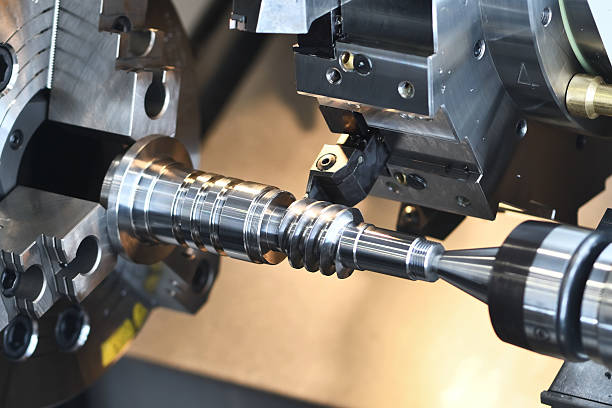
metalworking industry. cutting tool making metal worm shaft at machining center
CNC machining of 304 stainless steel
The machining of steel involves the use of specialized tools to cut and shape steel. Each grade of steel presents its unique challenges and considerations when it comes to machining.
The table below describes the scope of machining and fabrication with various steel grades;
| Steel Grade | Machining | Fabrication |
|---|---|---|
| A36 | Easy to machine with standard tools. Keep tooling sharp to avoid overheating. | Suitable for welding applications. Easily cut with a torch. Flame-cut edges will be somewhat rough and can be easily machined. |
| 4140 | Can be tough on tools due to its medium-carbon alloy steel composition. Recommended to use rigid and robust machine setups and carbide tooling for optimal results. | Can be cut and shaped easily. Requires more robust equipment to fabricate due to its high strength and hardness. Needs to be preheated to avoid cracking when welded. |
| 304 Stainless Steel | Has a tendency to work harden, which can make machining challenging. Using slow speeds and heavy, consistent feeds can help manage this issue. | Can be readily brake or roll-formed into various parts. Very suitable for welding. Has good drawability. |
It is essential to understand the properties of different steel grades to choose the right machining and fabrication methods. The selection of the right grade of steel can significantly affect the final product’s performance, lifespan, and overall cost. Understanding these properties will also help to prevent material failure, reduce waste, and increase productivity. Furthermore, if you want to read about common grades in steel CNC machining, you can read about 4130 vs 4140 and 4140 vs 4340 steel here.
Prolean’s Steel Machining and Fabrication Services
At Prolean, we provide custom machining steel and fabrication services for different steel grades, including A36, 4140, and 304 stainless steel. With a comprehensive understanding of the unique properties of these materials, we tailor our processes to achieve the best results. Whether it’s the machining of A36 steel or the fabrication of 4140 steel, we have the tools, skills, and experience to deliver high-quality outputs.
For 304 stainless steel, we optimize our machining speeds and feeds to counter its work-hardening characteristics. Our fabricators are adept at forming and welding this material, always adhering to best practices for optimal results. We pride ourselves on delivering bespoke solutions that meet the diverse needs of our clients. At Prolean, quality, precision, and customer satisfaction are our hallmarks.
Read more: Titanium vs Steel
Conclusion
Steel, with its plethora of types, offers a wide range of properties that make it suitable for various applications. From construction to automotive to kitchenware, different grades of steel serve specific needs due to their unique properties. Knowledge of these properties can guide the proper choice of steel for a project, ensuring performance and cost-effectiveness.
Prolean’s machining and fabrication services are equipped to work with these various steel grades, delivering optimal results tailored to each material’s characteristics.
FAQs
What are the properties of A36 steel?
A36 steel is known for its good weldability, machinability, and ductility, making it ideal for construction and building applications.
How does 4140 steel differ from A36 steel?
4140 steel is a medium-carbon alloy steel that has higher strength and hardness compared to A36 steel. It is often used in applications where strength is a primary concern.
Is 304 stainless steel good for machining?
304 stainless steel can be challenging to machine due to its work-hardening property. However, using slow speeds and heavy, consistent feeds can help manage this issue.
What services does Prolean offer for steel machining and fabrication?
Prolean offers a range of services including CNC machining, welding, forming, and more for different grades of steel.
How does Prolean ensure the quality of its services?
Prolean follows strict quality control procedures and utilizes state-of-the-art equipment to ensure precision and high-quality outputs.



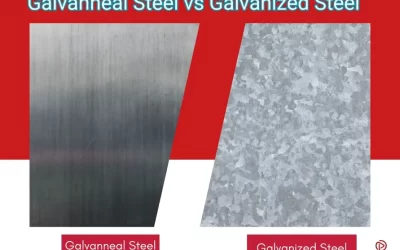
0 Comments